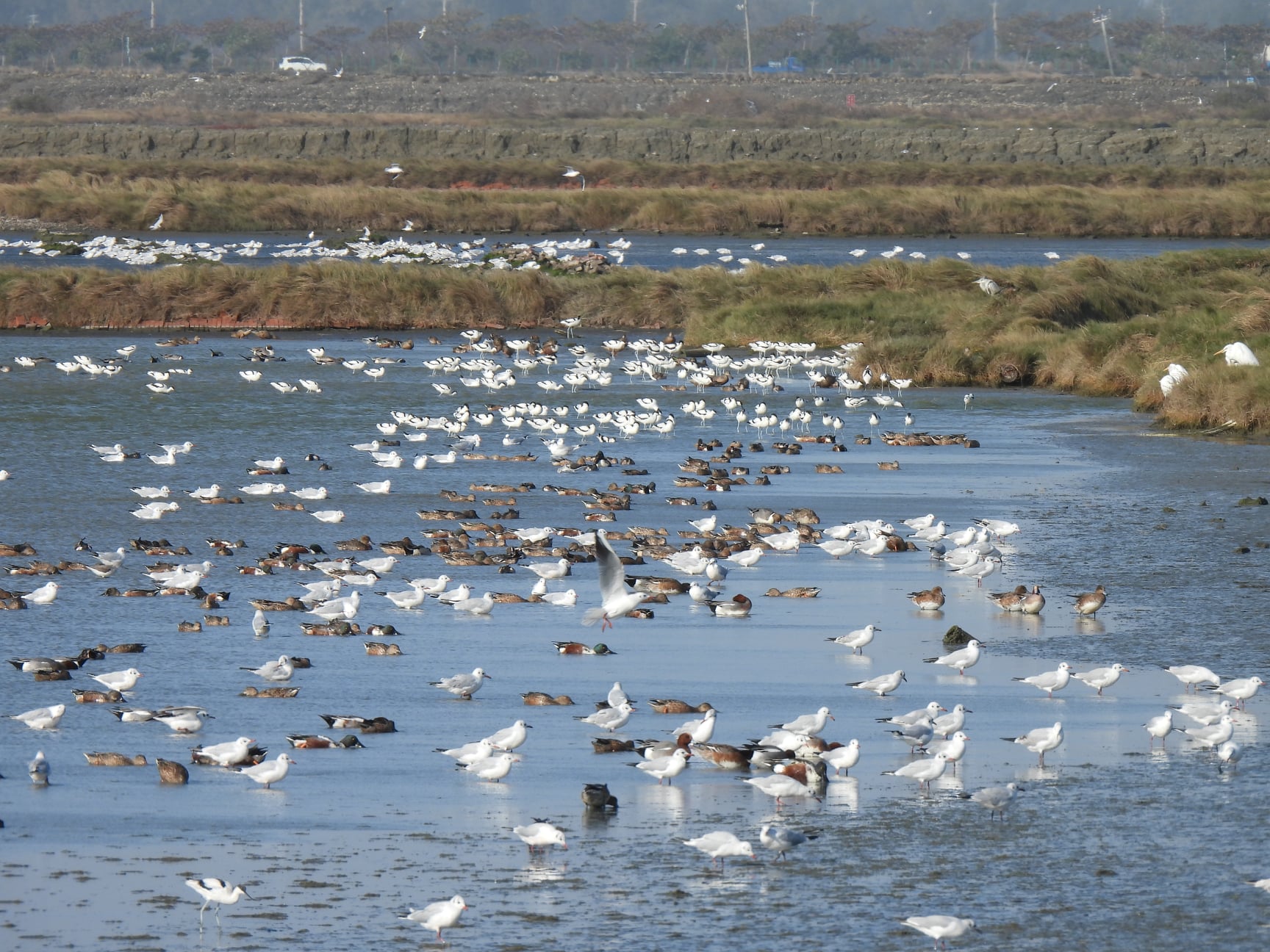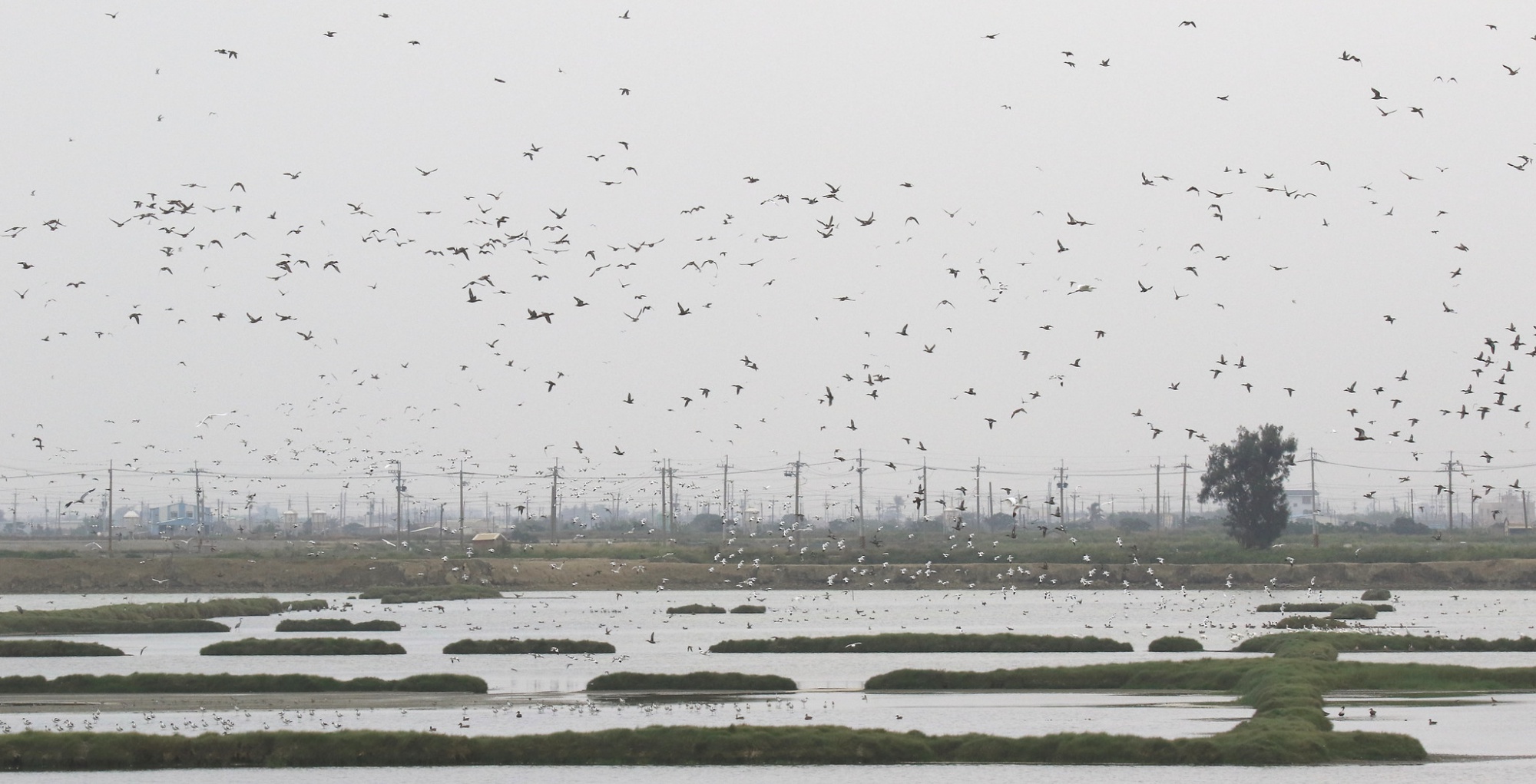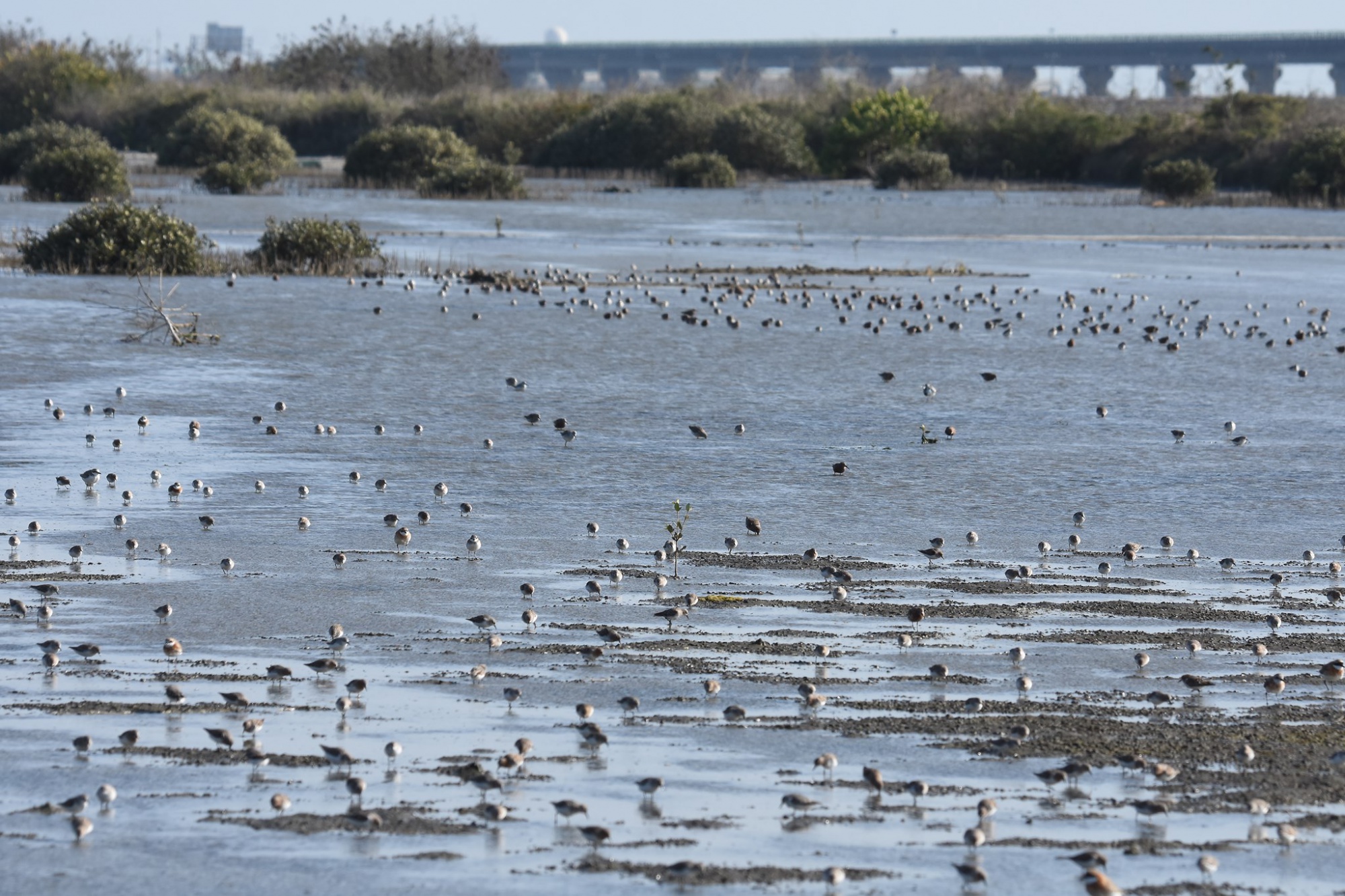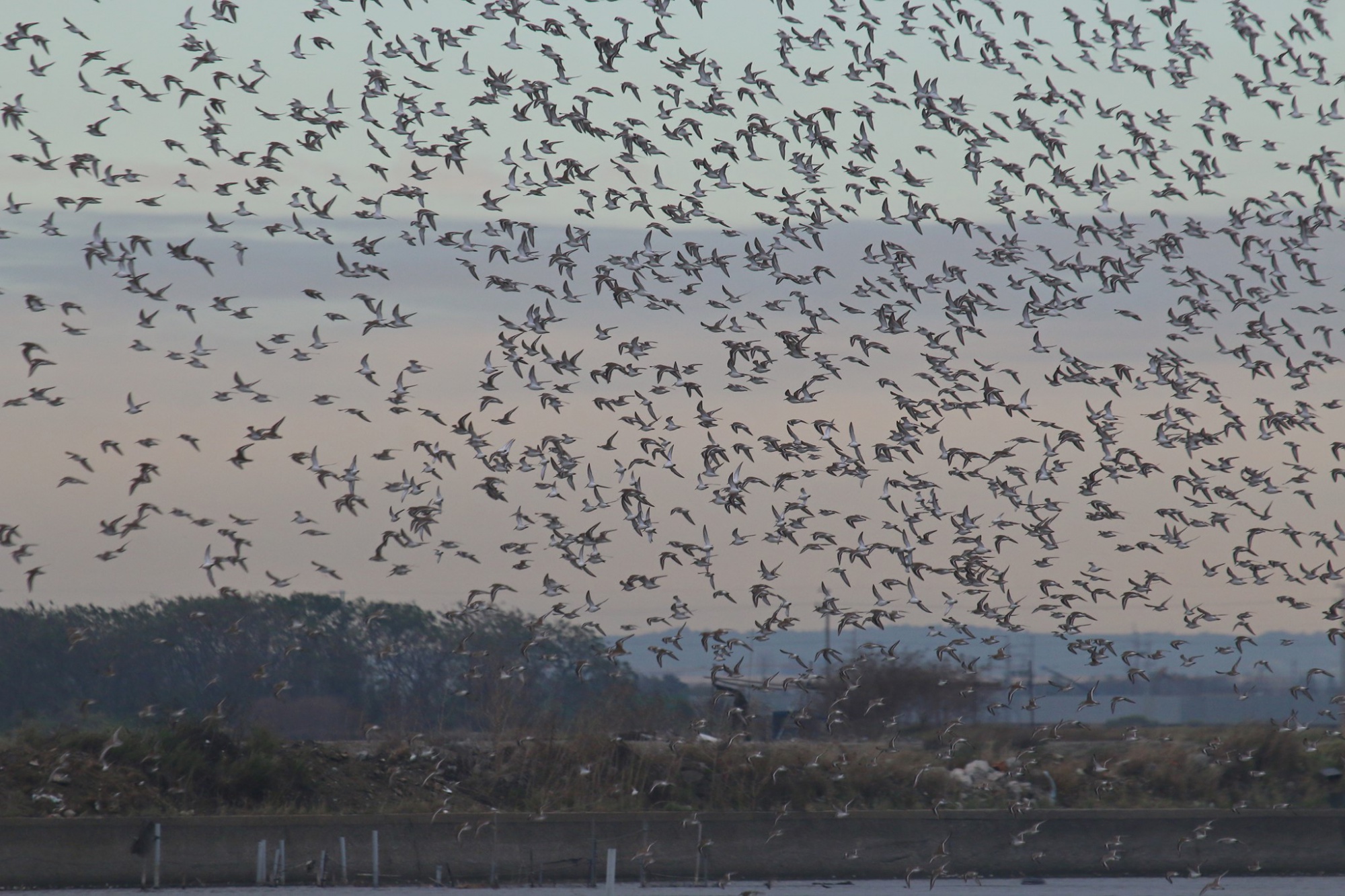【聯合聲明】國有鹽灘地非劣化棲地 保育共識不應走回頭路
5月份在網路媒體有學者投書,其觀察嘉義、台南鹽田濕地目前環境劣化越來越嚴重,不應放任不作為,並認為特有生物研究保育中心(簡稱特生中心)所繪製的鹽田生態敏感區的圖層分析不嚴謹,致國產署以錯誤的圖資做成行政命令之依據,其主張國有財產署應撤回行政命令並准予光電廠商申請開發,讓光電業者投入資源進行復育與管理,創造綠能與保育的雙贏。
中華民國野鳥學會、台南市野鳥學會、台灣黑面琵鷺保育學會及高雄市野鳥學會針對此投書有不同的見解,我們的意見與聲明如下:
國有鹽灘地多為鳥類生態豐富的熱區,不是已劣化的棲地
嘉義與台南沿海的國有鹽灘地,是目前全國遷徙水鳥數量最龐大且集中的重要棲息地,近年來無論是特生中心與成功大學的研究調查,以及賞鳥人的公民科學資料,都認定這些鹽田是無庸置疑的水鳥熱區,棲息著各式各樣包含雁鴨、鷸鴴、鷺鷥及鷗類等度冬水鳥。其中,嘉義布袋鹽田每年冬季約調查有3萬5千至4萬隻的鳥類,是為全國目前已知數量最多且集中的水鳥棲地;台南將軍與頂山鹽田近年也有數千至1萬多隻,且近年也持續記錄到特殊少見的瀕危物種如琵嘴鷸及諾氏鷸。無論以區域或全國的尺度來看,這些鹽田濕地的鳥種及數量皆相當突出,其中布袋鹽田的度冬水鳥數量更是全國之冠。我們認為這樣鳥類生態豐富的區域,生態狀況還相當良好,而非已經劣化的棲地,這也是這些地區不適合放置光電的主因。
棲地劣化應積極管理,但鋪設光電不是解藥
假如鹽田環境真的有劣化的狀況,確實應要積極面對來處理。鹽田濕地過去是曬鹽場地,原本就屬於動態的人為環境,台灣鹽業停止曬鹽後,鹽田處於閒置狀態缺乏管理,天然降雨多寡及水閘門的水位調控等就變成是影響在地生態的要素,若經營管理得宜,可以發揮更好的生態服務功能,提供更多的鳥類棲息並提高生物多樣性。但我們無法認同將眾所皆知的生態熱區描繪成已經劣化的棲地,並用「低度擾動」來合理化光電開發的影響,讓廠商進行開發後再進行棲地復育的思維。我們必須要強調,在鹽灘地鋪設大面積的光電板對於棲息於此的水鳥來說,絕對不是「低度擾動」,多數的水鳥需要開闊的濕地環境供覓食和休息。保護在地鳥類生態,應優先考慮保留現有的生態豐富的鹽灘地,而不是讓光電廠商去開發這些環境良好的地方,才另做生態補償,這是本末倒置的作法,同時也無法保證花了許多經費所做的棲地復育,一定就能恢復原有的生態樣貌。
鹽田光電爭議多,迴避生態熱區才是出路
過去於106年起,經濟部在嘉義與台南國有鹽灘地推動光電示範案場,在排除既有法定保護區後,共劃設758公頃的鹽田濕地作為光電設廠的預定地,卻仍坐落全台數量最豐富的重要水鳥棲地,鳥類豐富度並不輸鄰近法定保護區,引發光電衝擊生態的爭議。因此行政院、經濟部、農委會及公民團體經數次溝通協商後,以特生中心所繪製的鹽田生態敏感區地圖為依據(包含特生中心、成功大學與eBird鳥類紀錄資料庫的資料),將高度生態爭議區排除於光電示範案場外,改往中度及低度生態爭議區進行開發,即為現今已完工的嘉義義竹八區光電廠(80公頃)、新塭九區光電廠(22公頃)與台南鹽田光電廠(213公頃)。
實際上,無論是高、中、低度生態爭議的鹽灘地,只要管理妥當,理應都有具備生態功能的價值。迴避高度生態爭議區是綠能政策與生態保育的權衡結果,嘉義八區及九區的廠商也規畫棲地復育區來作棲地補償,但作用在於盡量減緩開發的衝擊,並非毫無影響。在全球天然濕地大量流失的前提下,為了能保障候鳥有永久的棲身之所,我們認為未來應盡可能保留重要的鳥類棲地,不應再設置更多的光電於國有鹽灘地上。但在去(109)年期間,因行政院與公民團體的共識未確實傳達到國有財產署,以至於部分光電廠商仍持續向國產署申請位在高生態爭議區的國有鹽灘地進行開發。經本會與相關團體、學者共同發起聲明,國產署亦召開會議了解問題之嚴重性,決議將所有申請在高生態敏感區的光電設廠案撤回,才免除大規模的環境開發壓力。
降低光電與生態、社會的衝突是共識,不應走回頭路。
近年來光電政策歷經種種爭議,為了減少與環境、社會面的衝突,針對2025年綠能發電量的目標,經濟部一方面增加屋頂型光電、減少地面型光電的比例外,也與農委會優先推行讓魚塭經濟加值的漁電共生型的光電,並研擬環境與社會檢核機制(簡稱環社檢核),盤點各種可能具爭議的議題,以供光電廠商提出有效的因應對策來降低開發的衝突。目前漁電共生光電還在初步執行且成果未定的階段,環社檢核機制也尚未應用到其他類型的地面型光電(如農電共生、埤塘光電等)。如今有學者回頭質疑特生中心評估的鹽田生態爭議區的可信度,並主張光電業者可以在其認定的劣化鹽田上進行開發和復育,恐怕不只讓已暫時平息的爭議又起,也讓國家的綠能政策可能再度被掛上破壞環境的汙名。我們能預期未來的光電爭議不會就此消失,但降低光電與生態、社會的衝突應是台灣社會多數人的共識,不該再走回頭路。
民間組織擬結盟認養國有鹽灘地,開創鹽田明智利用新出路
雖然目前嘉義、台南的國有鹽灘地鳥類生態豐富,但在缺乏實際管理的現況下,其中難免有非法侵占破壞或傾倒廢棄物等亂象,如果繼續放任而置之不理,確實可能造成部分環境劣化及汙染。為了促進國有地永續經營,國產署也鼓勵民間環境團體認養「國有非公用邊際土地」,於今(110)年2月公告已修正的相關辦法原則,包含海岸地區、濕地、埤塘、山區等公有地,有認養意願者可提出認養計畫書向國產署來申請。目前台灣黑面琵鷺保育學會與高雄市野鳥學會已分別認養台南頂山鹽田與布袋十區鹽田,透過定期的巡護工作與水位調控來維護環境的樣貌及監測鳥類的動態。為了能更進一步的守望珍貴的鹽田濕地。在未來,台南、高雄及台北等公民團體也正醞釀成立聯盟,預計將共同向國產署申請擴大認養嘉義、台南地區的國有鹽灘地,期望藉由民間組織的串連與合作,透過長期監測巡護、社區合作與教育與有效的棲地經營,來一起維繫鹽田與生態共存的榮景。

嘉義布袋鹽田 / 林坤慧 攝
Budai Wetland, Chiayi County / Kun-hui Lin

嘉義布袋鹽田 / 呂翊維 攝
Budai Wetland, Chiayi County / Allen Lyu

台南將軍鹽田 / 林坤慧 攝
Jiangjun Salt Pans, Tainan City / Kun-hui Lin

台南將軍鹽田 / 李昱緯 攝
Jiangjun Salt Pans, Tainan City / Yu-wei Li
相關聲明:
20201015-【聯合聲明】籲請撤回台南將軍光電計畫、綠能規劃切記迴避生態熱區
20201111-【聯合聲明】讓綠能在對的地方發展、肯定國產署撤回高生態爭議國有地開發
[Joint Statement]
Nationalized Salt Pans are Not Degraded Habitats; The Conservation Movement Should Not Be Moving Backwards
In May 2021, an online media platform published a piece by an academic who noted that habitat degradation at salt pans in Chiayi County and Tainan City was worsening and that it needed to addressed. The piece also criticized prior analysis of salt pans for ecologically sensitive areas as not being rigorous enough. The study, done by the Council of Agriculture's Taiwan Endemic Species Research Institute (TESRI), led the National Property Administration (NPA) to put forward an administrative order blocking photovoltaic development in certain areas. The article closed with the academic calling on the NPA to withdraw its current administrative order and allow photovoltaic manufacturers to apply for projects in these areas. The companies would then be able to devote resources towards rehabilitation and management of these salt pans, creating a win-win situation for both green energy and conservation.
The Taiwan Wild Bird Federation, the Wild Bird Society of Tainan, the Taiwan Black-faced Spoonbill Conservation Association, and the Kaohsiung Wild Bird Society all share a different opinion to that of this submission. Our statement on the matter is as follows:
Most Nationalized Salt Pans are Avian Ecological Hotspots, not Degraded Habitats
The nationalized salt pans along the coast of Chiayi County and Tainan City are important habitats with the largest and most concentrated numbers of migratory waterbirds in the country. Over the last few years, surveys conducted by TESRI and National Cheng Kung University, as well as data provided from both birdwatchers and citizen science projects, have all confirmed that these salt pans are undoubtedly waterbird hotspots. They are particularly important for wintering waterbirds such as ducks, geese, sandpipers, plovers, egrets, herons and gulls. In fact, around 35,000-40,000 birds are counted at Chaiyi's Budai Wetland each winter, making it one of the most important salt pans in the country. This is the highest concentration and number of waterbirds in the country. Meanwhile, Tainan City's Jiangjun and Dingshan salt pans see anywhere from 1,000-10,000 waterbirds each year, including globally threatened species such as the Spoonbilled Sandpiper and Nordmann's Greenshank. Whether looking at these numbers from either a regional or national scale, be it species or individuals, these salt pans are critically important. We believe that the ecological conditions of such bird-rich areas are still quite good, not degraded, which is the main reason why these areas are not suitable for photovoltaic energy projects.
Habitat Degradation Should be Actively Managed, Installing Photovoltaics is not the Solution
Of course if the environmental conditions at the salt pans are really deteriorating, it should be actively addressed. After Taiwan's salt industry halted production, the salt pans were left idle and unmanaged. Rainfall amounts and water level control at sluice gates became major factors affecting the ecology of these sites. However, we cannot agree with this notion of portraying well-known ecological hotspots as degraded habitats and rationalizing the impact of photovoltaic development with "low disturbance"; thus allowing manufacturers to develop and then rehabilitate these area. We must emphasize that the installation of large photovoltaic panels on salt pans is definitely not "low disturbance" to the waterbirds that need large open areas for both feeding and roosting. To protect the local ecology for birds, priority should be given to preserving the existing and already ecologically-sound salt pans. This is better than allowing photovoltaics companies to develop these areas and then provide some form of ecological compensation later. This is like putting the cart before the horse. There is also no guarantee that spending large amounts of money on habitat restoration will restore these areas to their original ecological appearance or function.
Salt Pan Photovoltaic Projects Disturb Local Ecology, Avoiding Ecological Hotspots is the Way to Go
Since 2017, the Ministry of Economic Affairs (MOEA) has been promoting photovoltaic demonstration sites in both Chiayi and Tainan's salt pans. After excluding existing conservation areas protected by law, a total of 758 ha of salt pan were designated for photovoltaic installations. Yet these were still located in the richest and most important waterbird habitats in Taiwan. The abundance of birds in these areas is no less than that of the neighboring legally protected areas. This led to controversy surrounding the impact of photovoltaic developments on local ecology. Therefore, several rounds of talks and consultations took place between the Executive Yuan, the MOEA, the Council of Agriculture, and local civic groups, resulting in TESRI preparing an ecological sensitivity map for the nationalized salt pans (including data from TESRI, National Cheng Kung University, and the eBird record database). After consulting the created sensitivity maps, areas of high ecological sensitivity were to be excluded from photovoltaic demonstration project sites. Meanwhile, areas of low and medium ecological sensitivity were to be used instead. The Section 8 Photovoltaic Installation in Yizhu, Chiayi (80 ha), the Section 9 Photovoltaic Installation at Xinying, Chiayi (22 ha), and the Salt Pan Photovoltaic Installation in Tainan (213 ha) have all been completed already.
In fact, regardless of the level of ecological sensitivity at these salt pans, they could all have some form of ecological function and value if effectively managed. However, avoiding areas of high ecological sensitivity is part of a trade-off between green energy policy and ecological conservation. The photovoltaic installation plans for both Section 8 and Section 9 in Chiayi include portions dedicated to habitat restoration and habitat compensation. Yet the goal there is to minimize the impact of development, not avoid impact altogether. In lieu of the rapid global loss of natural wetlands, and to protect this permanent habitat of migratory birds, we believe that in the future, important bird habitats should be preserved, and that new photovoltaic installments should not be placed on these nationalized salt pans. However, last year (2020), the consensus between the Executive Yuan and civic groups was not conveyed to the NPA, so there were still some photovoltaic companies continuing to apply to the NPA to develop highly sensitive ecological areas. After our organization issued a statement alongside numerous conservation-related organizations and scholars, the NPA called a meeting to understand the seriousness of the problem. It was then decided that all applications for photovoltaic installments in highly sensitive ecological areas would be stopped or withdrawn, thus eliminating the pressure of large-scale development in these environments.
To Reduce the Conflict Between Photovoltaics, Ecology, and Society, the Key is Consensus, Not Going Backwards
Recently, the country's photovoltaics policy has experienced various controversies. In order to reduce conflicts between the environment and society and with the goal of still reaching the nation's 2025 green energy goals, the MOEA has increased proportion of rooftop photovoltaics and reduced the proportion of ground photovoltaics. In addition, the MOEA, in cooperation with the Council of Agriculture, have given priority to the implementation of "floatovoltaics", a fishery and electricity symbiosis-type installment that adds value to the fish farm's economic prospects. An environmental and societalal review mechanism (ESR), which aims to inventory various potential conflicts for photovoltaic manufacturers in order to devise effective countermeasures to reduce such issues, has also been created. At present, the development of floatovoltaics is still in its preliminary implementation stage and the results are yet to be determined. Meanwhile, the ESR has not been applied to other forms of ground-type photovoltaic projects (such as on agricultural land or traditional fishponds). Recently, some scholars now question the credibility of TESRI's assessment of salt pan ecological sensitivity while also advocating for the photovoltaic industry to be able to develop and rehabilitate degraded salt pan habitat. Comments such as these look to revive an issue which has already been settled and may once again stigmatize the country's green energy policy as one that is damaging to the environment. We can expect that the controversy surrounding photovoltaic power will not disappear anytime soon, but it should be the consensus of most people in Taiwanese society to reduce the conflict between photovoltaic power and ecology and society. We should not go backwards.
Civic Groups Plan to form an Alliance to Adopt Nationalized Salt Pans, Creating a New Way Forward
Although nationalized salt pans in Chiayi County and Tainan City are currently rich in bird ecology, in the absence of actual management, there are inevitably going to be issues related to illegal encroachment, fragmentation, dumping of waste, etc. To promote the sustainable management of nationalized land, the NPA has been encouraging local environmental groups to adopt "National Non-Public Use Marginal Land". In February of this year it announced the principles of the revised regulations for lands under this classification, including coastal areas, wetlands, traditional fishponds, mountain areas and other public lands. Currently, the Taiwan Black-faced Spoonbill Conservation Association has adopted salt pans in Tainan City's Dingshan Area while the Kaohsiung Wild Bird Society has adopted salt pans in Section 10 of Chaiyi's Budai Wetland. These groups are entrusted to maintain the local environment and monitor the movement of birds through regular patrol work and water level control. To further watch over these precious salt pans into the future, civic groups in Tainan, Kaohsiung and Taipei are in talks to form an alliance and are expected to jointly apply to the NPA to adopt more nationalized salt pans in Chiayi County and Tainan City. These NGOs hope that by working together, these important salt pans can be preserved and ecological coexistence through long-term monitoring and patrol, community cooperation and education, and effective habitat management can be maintained.
